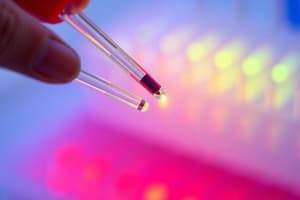Podcast
Questions and Answers
What is the recommended primer melting temperature (Tm) range for optimal PCR efficiency?
What is the recommended primer melting temperature (Tm) range for optimal PCR efficiency?
- 75°C - 80°C
- 52°C - 60°C (correct)
- 40°C - 50°C
- 65°C - 75°C
What is the acceptable difference in Tm between primer pairs for effective amplification?
What is the acceptable difference in Tm between primer pairs for effective amplification?
- < 15°C
- < 2°C
- < 5°C (correct)
- < 10°C
What is the optimal GC content for primers in PCR reactions?
What is the optimal GC content for primers in PCR reactions?
- 60-70%
- 45-55% (correct)
- 30-40%
- 50-60%
Which of the following is true regarding primer self-annealing during PCR?
Which of the following is true regarding primer self-annealing during PCR?
What is the maximum acceptable number of consecutive base runs in a primer design?
What is the maximum acceptable number of consecutive base runs in a primer design?
What method can be commonly used to check primer specificity and avoid non-target amplifications?
What method can be commonly used to check primer specificity and avoid non-target amplifications?
What characterizes a unique primer binding site within a template DNA?
What characterizes a unique primer binding site within a template DNA?
Why should primers with highly repetitive sequences be avoided when designing for genomic DNA?
Why should primers with highly repetitive sequences be avoided when designing for genomic DNA?
What is the primary purpose of designing unique primers for PCR?
What is the primary purpose of designing unique primers for PCR?
Which statement best describes universal primers?
Which statement best describes universal primers?
In the design of semi-universal primers, what is the first step according to the strategy?
In the design of semi-universal primers, what is the first step according to the strategy?
What is a major challenge when using multiplex PCR?
What is a major challenge when using multiplex PCR?
What role does Primer3 serve in PCR primer design?
What role does Primer3 serve in PCR primer design?
When designing a forward and reverse primer pair, what is a critical consideration?
When designing a forward and reverse primer pair, what is a critical consideration?
Which factor is crucial for maintaining specificity in PCR amplification?
Which factor is crucial for maintaining specificity in PCR amplification?
What would be a potential issue with a primer that is not unique?
What would be a potential issue with a primer that is not unique?
What is the primary purpose of RT-PCR?
What is the primary purpose of RT-PCR?
Which type of sample is most suitable for PCR amplification?
Which type of sample is most suitable for PCR amplification?
What is a crucial factor to ensure the specificity of primer annealing in PCR?
What is a crucial factor to ensure the specificity of primer annealing in PCR?
Which criterion is NOT typically considered in the design of PCR primers?
Which criterion is NOT typically considered in the design of PCR primers?
Which software feature is most beneficial for designing appropriate primers in PCR experiments?
Which software feature is most beneficial for designing appropriate primers in PCR experiments?
What type of PCR is primarily used to assess the presence of specific RNA sequences?
What type of PCR is primarily used to assess the presence of specific RNA sequences?
How does gel electrophoresis assist in PCR procedures?
How does gel electrophoresis assist in PCR procedures?
In PCR, what is the function of the extension step?
In PCR, what is the function of the extension step?
Flashcards are hidden until you start studying
Study Notes
Optimal Melting Temperature
- Optimal melting temperature (Tm) for primers is 52°C to 60°C
- Tm above 65°C should be avoided due to potential secondary annealing
- Higher Tm (75°C to 80°C) is recommended for amplifying DNA sequences with high GC content
Primer Pair Tm Mismatch
- Significant Tm mismatch between primer pairs can lead to poor amplification
- Desirable Tm difference is less than 5°C between the primer pair
Specificity
- Primer specificity is primarily determined by primer length and sequence
- Specificity depends on the nature of the template used in the PCR reaction
Cross Homology
- Cross homology can be a problem when PCR template is genomic DNA or a mixture of gene fragments
- Primers with highly repetitive sequences are prone to generating non-specific amplicons during genomic DNA amplification
Avoiding Non-Specific Amplification
- BLASTing PCR primers against NCBI non-redundant sequence database helps avoid designing primers that amplify non-targeted homologous regions
Primer G/C Content
- Optimal G/C content for primers is 45-55%
- Common G/C content range is 40-60%
Primer Runs
- Long primer runs (single base stretches) increase the potential for mis-priming (non-specific annealing)
- Maximum acceptable number of runs is 4 bp
Primer Repeats
- Repeats (consecutive di-nucleotide) increase the potential for mis-priming
- Maximum acceptable number of repeats is 4 di-nucleotide
Primer Internal Structure
- Primers that anneal to themselves or to each other, rather than to the template, decrease PCR efficiency
- These structures can be harmless if the annealing temperature does not allow them to form
Primer Uniqueness
- There should be only one target site in the template DNA where the primer binds
- Primer sequence should be unique in the template DNA
- The primer should not anneal to possible contaminant sources, such as human, rat, or mouse DNA
Multiplex PCR
- Multiple primer pairs can be added to the same PCR tube
- Useful for amplifying multiple sites simultaneously
- Application examples include genome identification
- Design difficulties include ensuring similar melting temperatures for all primers and avoiding primer dimer formation
Universal Primers
- Primers can be designed to amplify multiple products from a group of sequences
- These primers are called "universal primers"
- Example: designing primers to amplify all HPV genes
- Strategy includes identifying conservative regions at the 5' and 3' ends of the sequences and designing primers to target those regions
Semi-Universal Primers
- Primers can be designed to amplify only a subset of template sequences from a larger group
- Example: designing primers to amplify HPV type 1 and 6, but not other types
- Strategy involves identifying a subset of genes more similar to each other than to other subsets and designing primers to target those similarities
PCR Reaction Components
- Deoxynucleotide triphosphates (dNTPs): Building blocks for DNA polymerase to synthesize a new DNA strand
- Buffer solution: Provides a suitable chemical environment for optimal DNA polymerase activity and stability
- Divalent cations: Magnesium or manganese ions are needed; Mg2+ is typically used, while Mn2+ can be used for PCR-mediated DNA mutagenesis
PCR Reaction Volume
- PCR reaction volume is typically 20-150 μl in small reaction tubes (0.2-0.5 ml volumes)
Thermal Cycler
- Thermal cycler heats and cools the reaction tubes during PCR, enabling rapid temperature changes
PCR Procedure
- PCR usually involves 20-40 cycles of repeated temperature changes
- Each cycle consists of 2-3 temperature steps:
- Denaturation
- Annealing
- Extension
Stages of PCR
- Denaturation: Separates the double-stranded DNA template
- Annealing: Primers bind to the complementary sequence on the template DNA
- Extension: DNA polymerase extends the primers, synthesizing new DNA strands
Primer Importance in PCR
- Properly designed primers are crucial for a successful PCR experiment
- The primers should be specific for the target sequence and anneal properly to the template
Classical PCR
- Typical PCR reaction time is 1.5-2.5 hours
- Results in amplification of the DNA target sequence, generating a specific sized PCR product (amplicon)
PCR Detection methods
- Agarose gel electrophoresis: Enables separation of PCR products by size and visualization
- DNA ladder: A molecular weight marker containing DNA fragments of known sizes used for determining the size of the PCR product
RT-PCR (Reverse Transcriptase PCR)
- Used to amplify, isolate, or identify a known sequence from cellular or tissue RNA
- Involves reverse transcribing RNA into cDNA, followed by PCR amplification
Studying That Suits You
Use AI to generate personalized quizzes and flashcards to suit your learning preferences.




